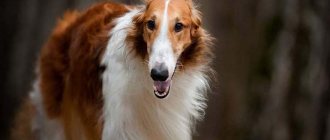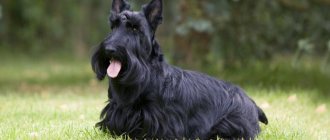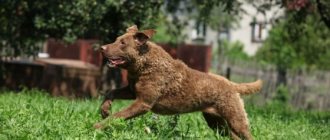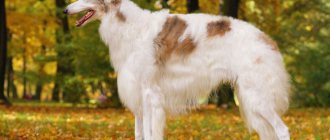Rottweilers are large breeds of dogs, with a strong build, powerful appearance and excellent guard qualities.
This is why this instills fear in many people about the animal, although some owners say the opposite. Many people say that at home the dog behaves affectionately and docilely, but it all depends on the upbringing.
However, the successes of the Rottweiler are clearly expressed in their ability to be bodyguards, watchmen, security guards, and search engines.
But at the same time, dogs of this breed can simply become beloved pets, equated to family members.
History of the breed
Reliable information has not reached our days about where the ancestors of the modern Rottweiler breed came from in Germany.
There is an opinion that strong butcher dogs accompanied the legions of the Roman Empire during their attack on European lands. But balanced and large Molossians could have come to Rome from Asian countries, where they lived long before, guarding the house and pasture.
When the Roman armies left Germany, their dogs remained there and began to mix with other breeds. As a result, the ancestors of the Rottweiler were born, suitable for guarding livestock and transporting cargo by butchers over long distances.
NOTE!
The breed was named after the city of Rottweil, where it was bred. The city itself is named after the red tiles that dominate the residents' houses.
Breeders liked the new breed of dogs for their endurance, courage, determination and trainability. As a reward, she was given the name of this city.
Short description
Rottweilers are massive, large animals, with well-developed muscles and a pleasant color.
Males are larger in build than females and heavier in weight - they weigh on average 50 kg, and females - about 40-42 kg. Height is 61-68 cm and 56-63 for male and female individuals, respectively.
The animal's head is medium in size, with prominent cheekbones. The Rottweiler's ears are triangular in shape, semi-erect, and also form a straight horizontal line with the top of the skull. The jaws are wide and the lips are black.
At first glance, it seems that the color of the breed is simple - black with brown markings. However, it has a complex structure due to the tan.
The tan is placed in the area of the cheeks, eyes, chest, neck, and front paws. The color of tan varies from gold to red-brown.
The dog’s character is dominated by the following qualities:
- courage, openness, decisiveness of action;
- Rottweilers do not show aggression without a reason;
- protection and security of the owner and his family with proper training;
- intelligence, excellent memory, quickly amenable to learning commands;
- cunning that can manifest itself with improper upbringing.
The lifespan of a Rottweiler is not too long - from 8 to 12 years.
IMPORTANT!
With proper care and concern for the pet's condition, the dog can live for 16 years.
But for this it is important to monitor his diet, provide high-quality care, regularly visit the veterinarian, and walk him daily.
Breed standard and description
Height at withers: males – 60-68 cm, females – 55-63 cm
Weight: males – 50 kg, females – 42 kg
Color: black. Brown markings are acceptable above the eyes, on the cheeks, in stripes on both sides of the muzzle, but not on the bridge of the nose. Spots can also be observed on the underside of the neck, in the form of two triangles on the chest, on the front legs to the wrist, on the inside of the legs to the knee joint , under the tail. The standard allows black stripes on the fingers.
Advantages and disadvantages
Rottweilers are completely domesticated and peaceful, intelligent and loyal to their owner. However, like any breed, there are some features in its character that you need to know for better mutual understanding with your pet.
The advantages of this breed include the following:
- Well-developed intelligence allows you to train the animal well, making it a reliable guard for the whole family, who is able to organize proper protection in the event of a threat;
- the Rottweiler has a relatively compact size, its body length is approximately 118-138 cm. This allows you to keep it in a medium or large apartment;
- slightly susceptible to shedding, little hair falls out. It can be combed out with a special roller and you won’t have to spend much effort cleaning the house from wool;
- the Rottweiler eats moderately, is not picky about food, can eat both dry food and home-cooked food;
- if the dog’s region of residence is in a temperate climate zone, then the animal can be kept in an enclosure in winter. There is no need to worry about your pet, since its two-layer coat will not let you freeze;
- a dog can become a loyal friend and family member.
Despite a lot of positive qualities, the dog’s character has the following negative aspects:
- You cannot keep him on a leash, as the dog considers this violence. The ideal option would be a built enclosure;
- There is laziness in the character, which can lead to health problems. Obesity develops from a sedentary lifestyle. To avoid this, the dog owner will need to exercise the dog with intense running, jumping, and long walks;
- potentially dangerous to others;
- The dog is incredibly cunning, he can pretend to avoid following commands. He needs an experienced trainer who can show his leadership;
- Rottweilers do not respond well to hot weather. At this time, you need to provide plenty of fluids and save the animal from overheating.
NOTE!
Before purchasing a dog, you should carefully weigh the pros and cons of this breed, and also familiarize yourself with the nuances of its character so that this does not come as a surprise to you and your loved ones.
Is the Rottweiler a miracle dog or a dangerous beast?
The Rottweiler is one of the most popular dog breeds in the world; according to various sources, it confidently retains its leading position in terms of sales in the world.
From the history of the breed
Ancient mastiffs brought to Europe by the Romans, which were used to accompany and guard legionary convoys, gave rise to the modern Rottweiler. The Rottweiler comes from the city of Rottweil in southern Germany, after which the breed got its name. Until the end of the 19th century, Rottweilers were considered butcher dogs (Metzgerhunde) and were used to accompany and guard livestock, as well as for transporting carcasses. At the beginning of the twentieth century, the breed was almost unknown outside Germany. At this time, the Rottweiler gained fame as a service dog. In the 30s, the Rottweiler was imported to America, Austria, Switzerland, Russia and gradually spread throughout the world. Proportional physique, above average height, dense coat and selfless devotion to the owner primarily characterize the Rottweiler. The Rottweiler is a strong, friendly and capable dog with a balanced temperament and good psyche. As a guard dog and family friend, the Rottweiler has no equal. Innate obedience, sense of duty, intelligence and unpretentiousness contribute to the enormous popularity of the breed.
Rottweiler training
You need to raise a Rottweiler from the very first months. It happens that even at two months a puppy begins to establish its own rules in the house. Therefore, in order not to get a one-year-old monster and a tyrant who does not listen to anyone, you should immediately begin training.
It is worth noting that the Rottweiler is a dog of one owner, that is, he will definitely honor and respect all family members, but only you will be his owner. This means that your commands and your behavior will be the priority behavior factors for the dog. Therefore, try to spend as much time as possible with your puppy in the first six months.
The puppy very quickly begins to recognize the sound of its bowl. Even if you accidentally touch it while he is sleeping, he will immediately wake up and run to the vessel. This can be used in teaching the “Come to me” command. When practicing this command on the street, after the puppy performs it, be sure to give him any treat. In the future, you need to train the animal to walk around you from behind, from right to left.
Simultaneously with the “Come to me” command, you can practice the “Sit” command. When outdoors, your dog should always sit next to your left leg. You can do this this way: take a piece of meat and use it to force the puppy to do what you want. Then reinforce the result with the command “Sit” and give the meat to the puppy. With the help of such stimulation, you can practice commands such as “Lie down” and “Stand”.
The “Lie down” command can be practiced in the following way. At the “Sit” command, sit the puppy down, then, gradually lowering your hand with the treat clamped in it, repeat the “Lie down” command. Also, one of the first things you need to learn is the “Fu” command. This is necessary so that the puppy at first does not take anything that gets into its mouth. When practicing this command, you can use a small force. For example, if your puppy grabs something from the ground while walking, lightly hit him with a twig and say “Ew.” In the same way, you can wean your dog from taking food from strangers.
Team training should begin with the help of treats, and after three months you can begin to use mechanical influence. It should also be remembered that commands learned through mechanical action are more persistent.
Temperament Friendly and peaceful, loving children, very affectionate, obedient, easily controlled and efficient. His appearance expresses primitiveness. Confident, strong-willed and fearless. He reacts with great attention to the world around him. Half of the dogs of the Rottweiler breed have no aggression towards their own kind or are expressed to a weak degree. Aggression towards children is absent in 40.9% of Rottweilers. Aggression towards the owner, frankly speaking, is absent in 78.8% of Rottweilers. Aggression towards family members, which can be expressed in insubordination and resistance to the influences of household members, as well as barking, growling and biting towards someone who is trying to control the dog, is absent among the examined Rottweiler population in 54.5% of dogs. Defender qualities are significantly expressed in 62.1% of Rottweilers.
Psychological characteristics of the breed
Frequency of occurrence of signs of various forms of severity characterizing the psychological characteristics of a dog:
| Sign | Degree of symptom expression | |||
| Absence | Weak | Moderate | Significant | |
| Dog stubbornness | 3,0% | 45,5% | 24,2% | 27,3% |
| Dog independence | 9,1% | 43,9% | 24,2% | 22,7% |
| Attachment to the owner | 0,0% | 0,0% | 10,6% | 89,4% |
| Sociability | 3,0% | 16,7% | 13,6% | 66,7% |
| Gaiety | 0,0% | 15,2% | 15,2% | 69,7% |
| Need for affection | 0,0% | 9,1% | 18,2% | 72,7% |
| Dog intelligence | 7,6% | 16,7% | 40,9% | 34,8% |
| Quick wits | 0,0% | 1,5% | 22,7% | 75,8% |
| Trainability | 0,0% | 6,1% | 22,7% | 71,2% |
More information about the psychological and physiological characteristics of Rottweilers www.rotweiler.ru/content/view/148/80/
The dog's stubbornness, that is, the dog's resistance to the owner's influences, plays a fairly important role in organizing a life with it, especially if this dog is physically strong and has sharp teeth. According to the owners, significantly expressed stubbornness occurs in 27.3% of Rottweiler dogs, moderately expressed stubbornness - in 24.2%.
Attitude towards children and pets
The Rottweiler is quite peaceful and loves affection, but if there are small children in the family, then perhaps you should think about purchasing another breed. It is highly not recommended to leave a large dog alone with a child; this breed is not a nanny or a toy for a child.
The independent character and self-esteem of the breed will not allow a child to bother and “cherish” even a well-trained, submissive dog for a long time. The resulting aggression will become a reflex reaction to children's games.
For children 13-14 years old, the Rottweiler will be an excellent companion when walking, but only if the dog is well educated and obedient to the owner and the child.
Representatives of the breed are loyal to other pets only if they grew up under the same roof from a young age. This must be taken into account when buying a dog, so that in the future the animals do not share the territory among themselves.
How much does it cost and where can I buy it?
Dogs of this breed have a price depending on the class.
- "By hand": up to $120 .
- PET class: up to $200-300 .
- BRID class: from $500 to $800 .
- SHOW class: from $700 to $1000 and above.
The most expensive, SHOW class are the best puppies of the entire litter. They are intended for participation in exhibitions. This is a kind of breed standard, fully meets the requirements and has no flaws.
The next most expensive dogs of the BRID class are healthy dogs with good pedigree and hereditary characteristics. The main task is to produce healthy and full-fledged puppies.
Next comes the PET class, and the name speaks for itself. These puppies are only fit to be pets. They have minor flaws, be it the wrong color or a crooked tail. Such puppies are not suitable for breeding, do not participate in exhibitions and therefore cost less. Purebred puppies can be purchased from breeders, they must have documents and a health guarantee.
By buying puppies secondhand, you save money, but there is no guarantee that your pet will be of good breeding and health.
Content Features
Before buying a dog, you need to carefully consider its maintenance and living conditions.
These animals can live in city apartments if the space allows. In a small room the dog will be uncomfortable, he will get bored and lazy, his character may deteriorate - disobedience and cunning will appear.
Living in apartment conditions can also negatively affect the dog's health and performance. The owner will have to devote more time to walks and monitor nutrition in order to prevent the pet from becoming loose.
A Rottweiler will be much more comfortable in a private home. To do this, you should equip a comfortable enclosure and a place where you can hide from bad weather. Rottweilers can easily overwinter in an enclosure in moderately cold winters - for this you should organize an insulated booth.
CAREFULLY!
Do not put your dog on a chain under any circumstances; this can lead to the development of aggression towards people.
Read more about caring for your Rottweiler here.











